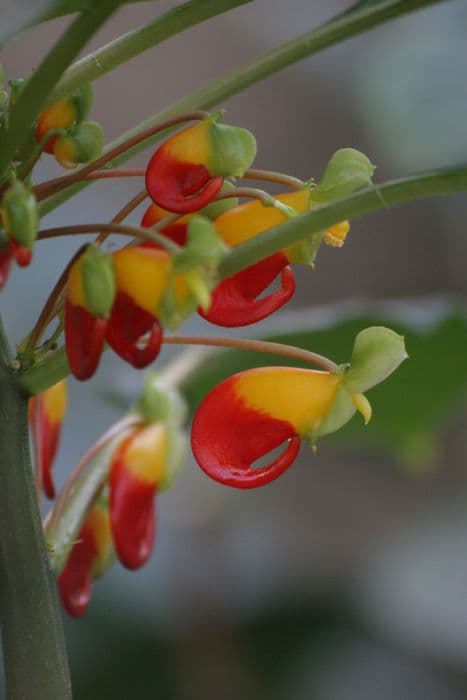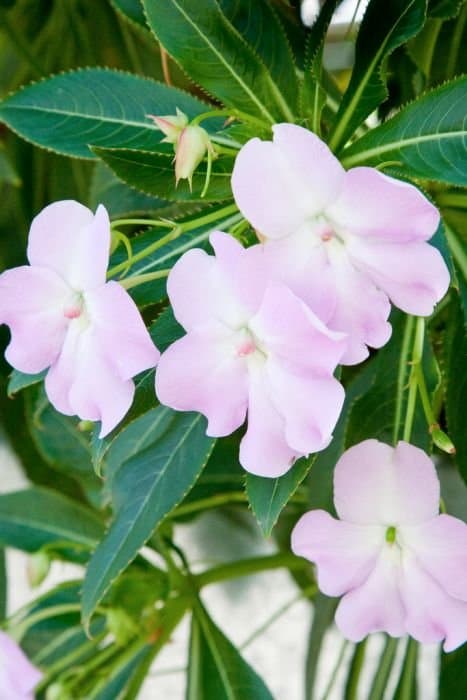African impatiens Impatiens tinctoria

ABOUT
The plant known as Impatiens tinctoria, often referred to as the African impatiens, exhibits a notable appearance characterized by its striking flowers and lush foliage. The flowers are large and eye-catching, typically white or pale pink with a contrasting throat marking of reddish-violet that adds to their allure. Each flower sports a characteristic spur, which is an elongated nectar-containing structure that extends from the back of the bloom. The leaves of the African impatiens are equally attractive, displaying a deep green color with a glossy texture, which provides a lush backdrop for the flowers. The leaf shape is elongated and comes to a point, with edges that are serrated, adding a textural quality to the plant's overall look. The foliage arrangement along the stem is opposite or whorled, creating a pleasing symmetry. The overall impression of the African impatiens is one of tropical vibrancy and lushness, with its showy florals and healthy greenery making it a popular choice for adding a splash of color to gardens or as a houseplant. Despite the absence of size specifications, the plant's visual appeal is characterized by a robust and compact appearance, indicating that it can serve as a focal point or an accent in various garden settings.
About this plant
 Names
NamesFamily
Balsaminaceae
Synonyms
African Touch-Me-Not, Dyer's Balsam, East African Impatiens
Common names
Impatiens holstii, Impatiens rothii, Impatiens schlechteri.
 Toxicity
ToxicityTo humans
Impatiens tinctoria, commonly known as the African impatiens, is not widely recognized as a toxic plant to humans. There is limited information available on the specific toxicity of this species of impatiens to humans. However, as with many plants, it is advisable to avoid ingesting any part of the plant without proper knowledge of its edibility and potential effects. If any part of the plant is ingested and adverse symptoms are experienced, medical advice should be sought.
To pets
Impatiens tinctoria, which is commonly referred to as the African impatiens, is similarly not well documented for its toxicity to pets. In general, impatiens are not known for being highly toxic to pets, but ingestion may still potentially cause mild stomach upset. It is always prudent to keep plants that are not confirmed as safe away from pets to prevent any possible ingestion. If a pet consumes any part of the plant and exhibits signs of distress, it is recommended to consult a veterinarian.
 Characteristics
CharacteristicsLife cycle
Perennials
Foliage type
Evergreen
Color of leaves
Green
Flower color
White
Height
6 feet (1.8 meters)
Spread
3 feet (0.9 meters)
Plant type
Herb
Hardiness zones
10
Native area
East Africa
Benefits
 General Benefits
General Benefits- Aesthetic Appeal: Impatiens tinctoria, commonly known as Amani Touch-Me-Not, has large and striking white flowers with a central mass of reddish-brown markings, adding beauty to gardens and landscapes.
- Pollinator Attraction: The nectar and pollen-rich flowers attract bees, butterflies, and other pollinators, supporting local ecosystems.
- Shade Tolerance: Amani Touch-Me-Not thrives in partial to full shade, making it suitable for planting in shaded areas where other plants might struggle.
- Easy Propagation: The plant can be easily propagated from seed or by cutting, facilitating quick and cost-effective garden expansions.
- Moisture Indicator: As a plant that prefers moist soil, its presence can indicate areas of the garden with adequate moisture, helpful for planning watering schedules and plant placement.
- Quick Growth: It grows relatively fast, providing quick coverage and filling up garden spaces efficiently.
 Medical Properties
Medical Properties- Anti-inflammatory: Impatiens tinctoria is known for its anti-inflammatory properties which may help in reducing inflammation and swelling.
- Analgesic: The plant has been traditionally used for its pain-relieving effects.
- Antipyretic: It has been used to treat fever due to its potential to lower body temperature.
- Antimicrobial: Impatiens tinctoria may possess compounds with antimicrobial activity against certain pathogens.
- Wound Healing: The plant is used in traditional medicine to promote the healing of wounds and cuts.
- Gastrointestinal Treatment: It has been used to alleviate various digestive issues.
 Air-purifying Qualities
Air-purifying QualitiesThis plant is not specifically known for air purifying qualities.
 Other Uses
Other Uses- Impatiens tinctoria, commonly known as wild impatiens, can be used in fabric dyeing due to the presence of vivid pigments in the flowers.
- The sap from wild impatiens stems can serve as a quick-drying glossy finish for small handicrafts and art projects.
- Leaves of Impress tinctoria might be boiled and the liquid used as a natural polish for wooden surfaces.
- Wild impatiens petals are sometimes incorporated into potpourris for their color and subtle fragrance.
- The seed pods of wild impatiens are popular for educational purposes to demonstrate the mechanism of seed dispersal via explosive dehiscence.
- Crushed leaves of wild impatiens can be rubbed on pet fur as an improvised shiny coat conditioner.
- The sturdy stems are occasionally woven into decorative items, like wreaths or small baskets, in some cultures.
- Flower enthusiasts may grow wild impatiens for competitive floral arranging due to their unique structure and striking appearance.
- Ink made from wild impatiens flowers has innovative uses in art communities for its natural origins and vibrant hues.
- Wild impatiens are sometimes planted as companions in gardens to create color contrasts with other flowers.
Interesting Facts
 Feng Shui
Feng ShuiThe Impatiens is not used in Feng Shui practice.
 Zodiac Sign Compitability
Zodiac Sign CompitabilityThe Impatiens is not used in astrology practice.
 Plant Symbolism
Plant Symbolism- Patience - As the name suggests, impatiens are often associated with patience or the lack thereof, hinting at how one might need to manage their impatience in various aspects of life.
- Hasty Decisions - The quick-to-bloom nature of the Abyssa can symbolize the tendency to make quick decisions or leap into situations without fully thinking them through.
- Enduring Stress - These plants can also stand for the ability to deal with stressful conditions, much like they endure diverse growing environments.
- Motherly Love - In some cultures, Abyssa is said to represent a mother's love, nurturing, and care, possibly due to its nurturing appearance and growth pattern.
 Water
WaterFor the Afromontane Impatiens, proper watering is crucial for maintaining its health. Water this plant regularly to keep the soil consistently moist but not waterlogged. During the growing season, typically spring and summer, you may need to water the plant approximately every 2 to 3 days, providing around 16 to 32 ounces of water each time, depending on the plant size and environmental conditions. In the cooler months of fall and winter, reduce the frequency to once a week, ensuring the top inch of soil has dried out before watering again. Overwatering can lead to root rot, so it's important to allow for proper drainage.
 Light
LightAfromontane Impatiens thrives in bright, indirect light. Place it in a spot where it can receive plenty of light without being exposed to direct sunlight, which can scorch its leaves. An east or north-facing window is often ideal, offering the soft morning light and protection from the harsh afternoon sun. If you're growing Afromontane Impatiens outdoors, provide partial shade, especially during the hottest part of the day.
 Temperature
TemperatureThe Afromontane Impatiens prefers a warm and stable temperature range. It is ideal to keep the plant in conditions between 60 to 75 degrees Fahrenheit for optimal growth. It can tolerate a minimum temperature of around 50 degrees Fahrenheit, but prolonged exposure to cold will harm the plant. Avoid placing it in locations with cold drafts or extreme temperature fluctuations to maintain its health.
 Pruning
PruningPrune Afromontane Impatiens to encourage bushier growth and remove any leggy or unhealthy stems. The best time for pruning is in the spring, just before the new growth starts. Trim back the stems by a few inches using clean, sharp shears. Pruning can be done every few months or as needed to shape the plant and remove any dead or yellowing leaves.
 Cleaning
CleaningAs needed
 Soil
SoilAfrican Impatiens thrives best in a rich, loamy soil mix with good drainage. A blend of two parts peat, one part loam, and one part perlite or sand is suitable. The ideal pH for the soil should be slightly acidic to neutral, ranging from 6.0 to 7.0.
 Repotting
RepottingAfrican Impatiens should be repotted annually, ideally in the spring before the onset of the rapid growth phase. Younger plants may benefit from more frequent repotting if they outgrow their containers.
 Humidity & Misting
Humidity & MistingAfrican Impatiens prefers high humidity levels, ideally around 70-80%. Consistent humidity supports healthy growth and bloom production, but avoid making the air stagnant to prevent disease issues.
 Suitable locations
Suitable locationsIndoor
Place African Impatiens in bright, indirect light indoors.
Outdoor
Grow African Impatiens in shade with moist soil outdoors.
Hardiness zone
10-11 USDA
 Life cycle
Life cycleImpatiens tinctoria, commonly known as the Abyssa Impatiens, begins its life cycle when its seeds germinate in moist, well-drained soil, usually in the shade or partial sun. After germination, the seedlings grow into juvenile plants, developing a characteristic sturdy stem and the species' notable ovate leaves. As the plant matures, it starts to produce striking white or pale yellow flowers with a central dark blotch, signaling its entrance into the reproductive stage. These flowers are pollinated by insects, which leads to the development of seed pods that burst upon maturity, dispersing seeds into the surrounding environment to start a new generation. In regions with favorable climate conditions, Abyssa Impatiens may continue to grow as a perennial, while in colder regions, it will complete its life cycle within a year, dying after seed dispersion. The survival of the next generation depends on the successful germination of these dispersed seeds, which is facilitated by the plant's preference for moist habitats.
 Propogation
PropogationPropogation time
Spring-Early Summer
Impatiens tinctoria, commonly known as the African impatiens, is a beautiful plant known for its striking flowers and ease of care. The most popular method of propagation for this plant is through seed sowing, which is typically best done in the spring. To propagate African impatiens from seeds, start by filling a seed tray with a well-draining seed starting mix. Sow the impatiens seeds on the surface and lightly press them into the soil, but do not cover them as they require light to germinate. Keep the soil consistently moist by watering with a fine mist and maintain a temperature of around 70 to 75 degrees Fahrenheit (21 to 24 degrees Celsius). Germination usually occurs within 15 to 20 days. After seedlings have sprouted and grown to a sufficient size, you can transplant them to individual pots or your garden.



![Busy lizzie [SunPatiens Compact Orange]](/_next/image?url=https%3A%2F%2Fplants-admin.emdemapps.com%2Fimages%2Fplants%2F%2Fimages%2F604b5ef883e70.png&w=640&q=75)
![Busy lizzie [SunPatiens Vigorous Magenta]](/_next/image?url=https%3A%2F%2Fplants-admin.emdemapps.com%2Fimages%2Fplants%2F%2Fimages%2F604b622adf631.png&w=640&q=75)

![Busy lizzie [Magnum Wild Salmon]](/_next/image?url=https%3A%2F%2Fplants-admin.emdemapps.com%2Fimages%2Fplants%2F%2Fimages%2F604b589ecbd54.png&w=640&q=75)
![Busy lizzie [Sun Harmony Compact Lavender]](/_next/image?url=https%3A%2F%2Fplants-admin.emdemapps.com%2Fimages%2Fplants%2F%2Fimages%2F604b61dd3f530.png&w=640&q=75)
![Busy lizzie [SunPatiens Compact Electric Orange]](/_next/image?url=https%3A%2F%2Fplants-admin.emdemapps.com%2Fimages%2Fplants%2F%2Fimages%2F604b63b73cfd3.png&w=640&q=75)
![Busy lizzie [SunPatiens Spreading Variegated White]](/_next/image?url=https%3A%2F%2Fplants-admin.emdemapps.com%2Fimages%2Fplants%2F%2Fimages%2F604b58ff08af7.png&w=640&q=75)